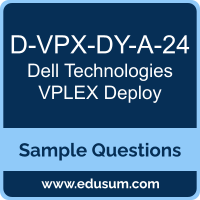 The purpose of this Sample Question Set is to provide you with information about the Dell Technologies VPLEX Deploy exam. These sample questions will make you very familiar with both the type and the difficulty level of the questions on the D-VPX-DY-A-24 certification test. To get familiar with real exam environment, we suggest you try our Sample Dell Technologies VPLEX Deploy Certification Practice Exam. This sample practice exam gives you the feeling of reality and is a clue to the questions asked in the actual Dell Technologies VPLEX Deploy certification exam.
The purpose of this Sample Question Set is to provide you with information about the Dell Technologies VPLEX Deploy exam. These sample questions will make you very familiar with both the type and the difficulty level of the questions on the D-VPX-DY-A-24 certification test. To get familiar with real exam environment, we suggest you try our Sample Dell Technologies VPLEX Deploy Certification Practice Exam. This sample practice exam gives you the feeling of reality and is a clue to the questions asked in the actual Dell Technologies VPLEX Deploy certification exam.
These sample questions are simple and basic questions that represent likeness to the real Dell Technologies D-VPX-DY-A-24 exam questions. To assess your readiness and performance with real time scenario based questions, we suggest you prepare with our Premium Dell Technologies VPLEX Deploy Certification Practice Exam. When you solve real time scenario based questions practically, you come across many difficulties that give you an opportunity to improve.
Dell Technologies D-VPX-DY-A-24 Sample Questions:
2. Create extent, create a device on the extent
3. Create a virtual volume
4. Present virtual volume to the host
2. Create device
3. Create extent on the device
4. Execute storage claim wizard
2. Mirror the virtual volume to native volume with data
3. Create device and create extent
4. Present virtual volume to host
2. Create extent
3. Create device
4. Create virtual volume
Answers:
|
Question: 01 Answer: d |
Question: 02 Answer: b |
Question: 03 Answer: a |
Question: 04 Answer: c |
Question: 05 Answer: d |
|
Question: 06 Answer: a |
Question: 07 Answer: c |
Question: 08 Answer: d |
Question: 09 Answer: b |
Question: 10 Answer: a |
Note: For any error in Dell Technologies VPLEX Deploy (D-VPX-DY-A-24) certification exam sample questions, please update us by writing an email on feedback@edusum.com.
